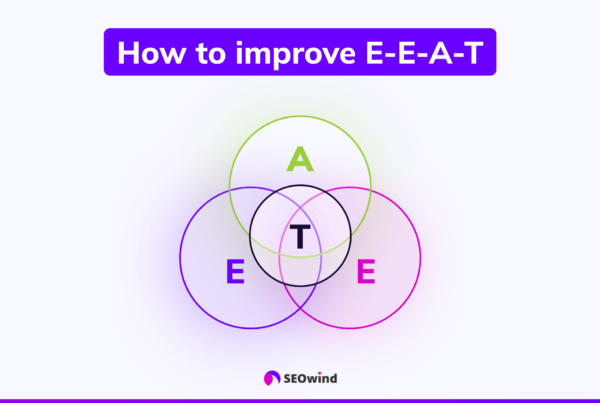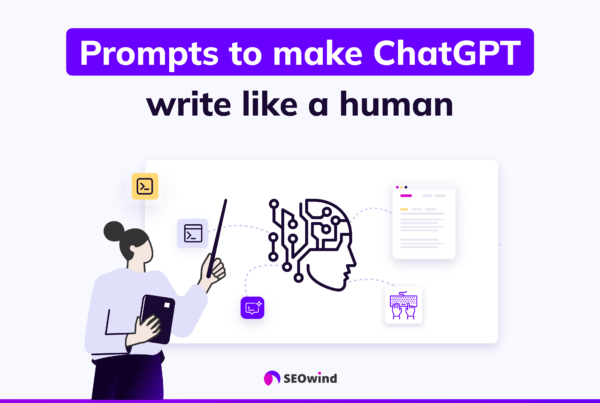With AI-generated content on the rise, more and more businesses are asking themselves if they should be using it in their marketing.
But is AI content really all it’s cracked up to be?
And if you do decide to use it, how can you make sure that your readers don’t end up feeling like they’re reading something artificial?
In this article, we’ll take a look at some of the pros and cons of using AI content creation. We’ll also offer some tips on how to make sure that your AI-generated content looks and feels as human as possible.
So whether you’re already using AI content or you’re just considering giving it a try, read on for some helpful advice!
TL;DR
- AI-driven content creation tools can be used for content ideation, content creation, SEO content, note-taking, voice assistance, and chatbots.
- The scope of AI content tools is rapidly expanding to cover any content need the user might have.
- AI content tools are ideal for marketers and content marketers wanting to maximize the reach of their campaigns, ensuring consistency in style and message across multiple channels.
- AI content generation tools can suggest topics and questions, display search terms users enter to find content and optimize SEO to produce better quality content.
- Two basic approaches are outsourcing the whole writing to an AI content tool and treating the AI content tool as a content assistant.
- It is important to provide clear instructions to AI content tools to ensure that the generated content is not artificial and feels human.
- AI-driven content creation tools are becoming a central part of the modern marketing toolbox but it should be used wisely.
What is AI-generated content?
Simply put, AI-generated content is any written material that a machine or automated assistant produces. This includes blogs, articles, product descriptions, and anything else that AI can cover. This process relies on automated content creation tools that take in key information inputted by human users. Afterward, the tool will use that as the basis for content creation.
This approach cuts time, as lengthy research sessions become obsolete and the collated information reliably makes it into the content. Organizations can also save money by avoiding the need for hiring a copywriter while simultaneously improving SEO activity. Just keep in mind that many tools risk plagiarism and/or lower-quality published content.
What Is AI-Powered Content Creation and Strategy?
All automated content generation does is create content for you. It is a time saver and helps you meet your deadlines. This does not mean you do not do any work. You still have to give the tool certain parameters, some descriptions, and prompting, but in essence, you do not write the content all by yourself.
The AI SEO content generator does all the hard work for you. This may be a good tool to help you when you face writer’s block. This situation is devastating to some writers as they cannot think of one word to write.
This condition can last for a long period of time. That is one situation where you could use an artificial intelligence content writing tool to help you get past that block.
These tools are a writer’s aid when they need help thinking of topics to write about.
What is an AI Content Creation Tool?
AI content writing tools use AI algorithms to develop creative and engaging content that is tailored specifically to the user’s needs. This technology has revolutionized the way we create content, allowing us to write more creative and high-quality material faster than ever before.
AI content generation tools analyze a variety of input data sources, including demographic information, research reviews, behavior analytics, text analysis, and more. AI algorithms then generate fully original content based on this data to produce unique pieces that are truly representative of their target audience’s tastes and interests. What’s more, these AI content marketing tools can do this in a few seconds.
AI Content Generation Use Cases
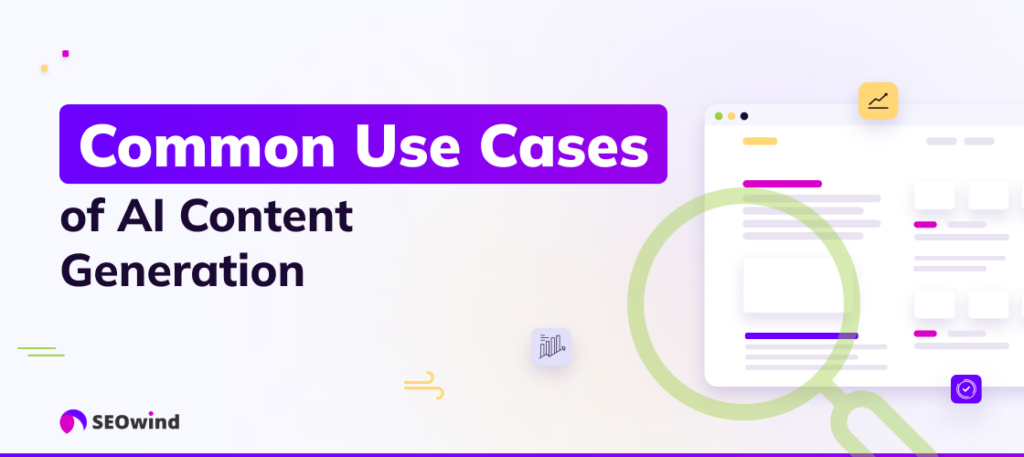
There are different situations in which you can use AI-driven content creation to help you get your work done on time. Here are a few of those situations:
1. Content Ideation
This situation is where you are only using AI content tools to help you get ideas for your blog, articles, outline, and everything related to those aspects of writing. AI tools can quickly generate ideas from conversation data and research, giving brands a fast and effective way to create better quality content with AI’s assistance.
2. Automated content outlines and structure creation
With an idea in hand, structuring that concept becomes substantially less daunting when embracing AI content-creator tools. These solutions render large-scale structures by initializing logical frameworks based on successful articles within similar domains.
Like crafting a blueprint before erecting a building:
- Input Topic: You tell the AI what you plan to discuss.
- Intelligible Outlines: The tool promptly constructs an outline, including pertinent headings and subheadings.
- Customization Options: You may modify these suggestions, ensuring they perfectly align with your intended narrative flow and style.
By automating this step, writers maintain focus on fleshing out robust arguments instead of battling bouts of decision fatigue regarding organization—ultimately enhancing productivity and coherence throughout their pieces.
3. Content Creation
AI is doing most of the work with content writing for you. Your job is to provide the tool with clear instructions on what you would like it to write about. Most AI content tools can write for your blog posts, ads, social media posts, or any content for videos. The scope of tools, such as Jasper or Writesonic, is rapidly expanding to cover any content need the user might have.
There are two basic approaches people use when utilizing such tools:
Approach #1: Outsource the whole writing to an AI content tool
You can treat AI content tools as a copywriter. The content it writes you can basically copy-paste. No edits or rewrites.
[Spoiler alert: this might be a dangerous approach if not done right. We will talk about it later]Approach #2: Treat the AI content tool as your content assistant
You can perceive AI content tools as your content assistant. What I mean is that you can ask the tool to write some pieces of your content, like an introduction, conclusion, and paragraphs, or ask to improve your content. Make edits, and add your expertise and know-how on top.
4. SEO content
AI content tools can analyze data and make suggestions on keywords to use and their density, generate titles and meta descriptions, and many more.
5. Note Taking
Not everyone can take notes and get the information correct. These AI content generators can do all that for you. Not only do you get good notes, but you also spare your fingers & wrist from fatigue and pain.
6. Voice Assistance
Voice assistants that can respond to our questions can be created using techniques for AI content generation.
7. Chatbots
Chatbots have become one of the most popular services on the market. They can respond to the majority of queries in just a few seconds. The speech generator used by these AI-powered bots is often trained based on actual human dialogues.
Who can benefit from AI-driven content creation?
AI-driven content creation tools are becoming a central part of the modern marketing toolbox. AI content tools can be very helpful for businesses, offering more impactful and creative campaigns at lower costs, helping them reach more customers with high-quality content that is AI-driven.
1. Marketers
AI content creation tools are ideal for marketers wanting to maximize the reach of their campaigns as AI technology ensures consistency in style and message across multiple channels.
2. Content Marketers
AI content tools offer significant advantages to Content Marketers by allowing them to scale production while optimizing quality, saving time, and increasing engagement with their target audience across all distribution platforms.
Tools for creating content with AI can do more than just produce content. They also assist you in enhancing your SEO and understanding the type of material your audience prefers. AI content generation tools can:
- suggest topics and questions you should use to deliver more value to your users,
- display the search terms users enter on your website to find your material,
- make SEO optimization so you can instruct the AI to use the information it gathers to add useful keywords and phrases right into your writing,
- provide you with insights into the effectiveness of your content and chances to develop more successful content resources.
3. Social Media Marketers
AI also helps Social Media Marketers efficiently create highly engaging content that resonates well with users on social media platforms such as Instagram, Linkedin, Facebook, and Twitter.
AI tools may assist in identifying the most useful portions of any piece of material to use in social posts or different forms of social advertising, from headline variations to pull quotes and spotlight text.
They can even support you with posting, suggesting what is the best time to do it.
4. Marketing and content agencies
Marketing Agencies can benefit from AI Content Tools by streamlining processes, increasing output, and tracking performance metrics; combined these benefits provide a great way to get results faster and accurately identify areas where campaigns need improvement.
These different AI tools can take over for you when the mundane details of the job bog you down and delay your completing other work.
That gives you a chance to handle more important discussions that require a human touch.

How AI Content Generators Work
AI content generators create text using natural language generation (NLG) and natural language processing (NLP) approaches. This method of content creation helps distribute enterprise data, customize product descriptions, and adapt the information to user behavior.
Algorithms are used to organize and produce NLG-based content. These text generation models are frequently trained using a pre-training strategy that is unsupervised, allowing language transformer models to absorb and learn a variety of valuable information from huge datasets. Thanks to training on such massive amounts of data, the language model can dynamically generate increasingly accurate vector representations and probabilities of words, phrases, sentences, and paragraphs with contextual information.
Transformers solve this problem by allowing concurrent training and capturing longer sequence features, allowing for far more complete and efficient language models as the language model grows with the quantity of the data and the architecture.
Traditional architecture is gradually being replaced by transformers as the norm for NLG.
Transformers open the door for far more thorough and effective language models by enabling continuous training and capturing longer sequence information as the language model grows with data and architectural scale.
Modern AI systems, like GPT-4 or ChatGPT, aim to produce content that is impossible for most readers to distinguish from human creativity and writing style.
AI Tools for content generation
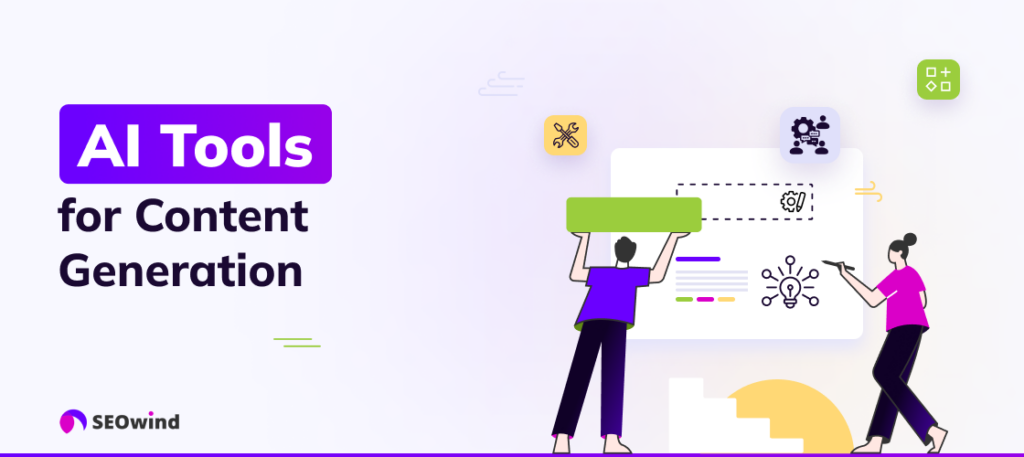
The terrain of digital content creation is continuously reshaped by innovative artificial intelligence techniques. In this vast and dynamic landscape, the best AI content generator tools emerge as vital companions to writers and marketers alike. Through them, you can unlock new levels of productivity and creativity. Let’s delve into a comparison that’ll help you discern which AI companion suits your narrative journey.
Overview of top AI tools for generating content ideas
Finding inspiration can sometimes feel like searching for water in a desert. Some of the most coveted best AI tools for content creation are designed to assist in sprouting vibrant content ideas from barren grounds.
- SEOwind: Renowned for its advanced SEO features, it helps you tailor your concepts to rank higher on search engine results pages.
- Jasper: It brings not only an intuitive interface but also the brainpower to generate inventive prompts.
- Rytr: Loved by many for its simplicity and efficiency in churning out quick suggestions.
- Writesonic: Prized for its versatility across various formats, from ads to blogs.
- Copy.ai: A user-friendly tool that offers diverse idea-generation capabilities.
Each one has unique elements that make them stand out; some may be more suited to long-form blog posts, while others excel at punchy social media snippets. Your choice might hinge on the type of audience you cater to or the platform you use most often.
Pros and cons of AI for content creation
As AI technology evolves, it is becoming increasingly capable of creating content for businesses. While some people may view this development with skepticism, there are many pros to consider when it comes to using AI for content generation. Here, we will explore the advantages and disadvantages of artificial intelligence-generated content.
Pros for using AI Content Generation Tools – why should I use AI writing tools?
1. Optimizes your content processes
They give businesses the opportunity to save time, resources, and money as they are less expensive to operate and work with.
2. Research is faster and more accurate
They can assess a massive amount of data to see what topics are worth covering. Moreover, they present the data in an easy-to-digest way so the only thing you need to do is use them.
3. Helps writers write
AI Content tools provide outlines, ideas, and even content to help writers be more productive. They are able to quickly generate a variety of accurately targeted and highly engaging written content while leveraging the collective intelligence of many authors. AI tools also enable users to get creative by providing nearly infinite options for customizing generated text, such as diction, style, tone, and length.
4. Boosts SEO
AI marketing tools can find the right keywords and phrases to improve SEO content and hopefully help it rank higher.
5. Takes Over Mundane Jobs
It does difficult and boring tasks to make sure customers are served better.
6. Helps you stay up-to-date
You can track and update AI-generated content over time with no additional effort required from the user, enabling businesses to keep their web pages fresh and up-to-date with customer preferences in real time.
Cons for using AI Content Generation – why shouldn’t I use AI writing tools?
1. May Write Inappropriate Content
This is always a risk as the AI content generators do not understand what is sensitive data. It just lacks judgment.
2. May be too creative
Be careful with the stats and quotes AI content tools provide you with. They often tend to be inaccurate.
3. Needs human input
You need this aspect to polish the content and add value on top. You’re an expert in the field, not the AI tool. You have experience and knowledge of what works and what doesn’t.
Where AI Content Does Work?
AI content creation is quickly becoming an attractive and efficient alternative to traditional content development.
AI tools are able to craft compelling pieces with accuracy and efficiency, freeing up valuable time for marketers and content producers. Still, AI tools aren’t capable of replacing all aspects of the creation process.
Often, AI-crafted content pieces require manual edits, to be perceived as more natural or be more tailored towards a certain audience base. AI content works best when used as part of a larger strategy that involves human input as well. As humans, we tend to have a better understanding of the current trends and popular topics that AI is still not able to comprehend.
AI does have its place in content creation, proving efficient for tasks such as researching keywords and analyzing data for insights that contribute to AI-crafted pieces. These tools can explore and analyze far more data than we possibly can. And they do this work at speeds that no human can achieve.
It does also a good job of generating questions a content writer needs to answer.
It works best in those scenarios that help employees produce more content and publish more frequently.
How to generate content with AI Writing Tools? Tips
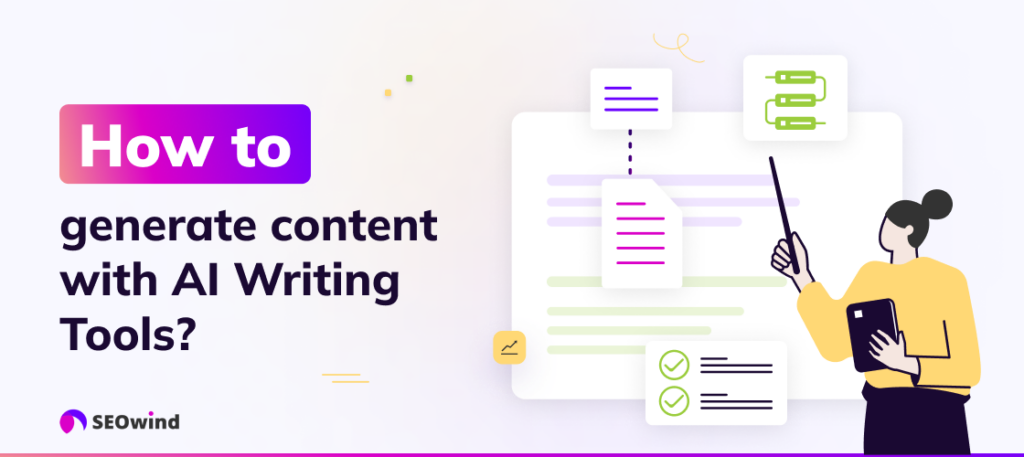
Some people might think that AI-generated content is plug and play solution. I would highly recommend not allowing AI tools to generate content for you but rather using it as your assistant to deliver more value and improve your writing.
Let me share with you some tips on how to make the most of it.
- Put Time And Thought Into Setup – You want the AI writing tool to have all the parameters it needs to generate good content. This will include telling it the tone you want it written, whether it is written in 1st or 3rd person, and other details.
- Check For Quality Before Publishing – Proofread and edit the AI-generated content to make sure it is on par with quality human writing.
- The more detailed your input is, the better the output will be.
- Learn From Your AI As It Learns From You – This tip helps you learn how to formulate better keywords, as well as develop better sentence structure.
- Don’t Rely Solely On AI-Generated Content – In other words, do not sacrifice the human touch for time and cost-saving AI content. Use AI content marketing tools as an aid to not a replacement of human writers and their personal touch.
Use AI Content Generation Tools with Your Expertise
Have you heard of the Cyborg Method? It’s a way to combine human creativity and machine intelligence.
Best practices for incorporating AI in content creation strategies
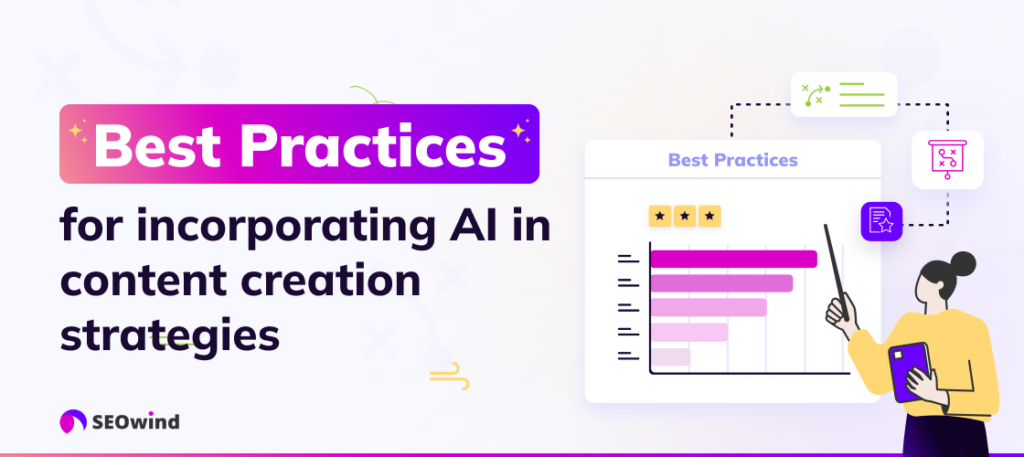
Artificial intelligence has become an indispensable ally. It’s essential to recognize, though, that the most effective use of AI isn’t about replacing human creativity but augmenting it. Picture yourself as a chef: AI is like having a robotic sous-chef — it can prepare ingredients and suggest combinations, but you’re the one who ensures everything comes together in perfect harmony.
Using AI as a supportive tool, not a replacement
When I talk about using AI for content creation, imagine wielding a sophisticated multi-tool. It can propel your writing to new heights if you employ it judiciously. Here’s how you do this without losing your unique voice:
- Set Clear Objectives: Before diving into AI-generated waters, have precise goals in mind. Are you using AI to speed up research, brainstorm ideas, or refine grammar? Understanding what you want from AI will set clear boundaries.
- Quality Control: Always fact-check and revise any information generated by AI tools. They’re adept at assembling data but lack discernment when it comes to accuracy.
- Personal Touch: Inject your personal insights and experiences into the content. This individuality is what resonates with readers and differentiates you from the sterile output that might come straight from an algorithm.
By adhering to these approaches, we ensure that AI serves as an enhancer rather than usurping our role as creators.
Creating a seamless workflow between humans and machines
Creating content with AI becomes deeply efficient when there’s a hand-in-glove relationship between technology and humanity. Here are several steps to integrate both smoothly:
- Begin with Brainstorming: Let AI tools ingest your raw ideas and generate various content themes or topics for you.
- Outlining Made Easy: Use AI to draft preliminary outlines, which can then be expanded upon with human insight.
- Draft Development: Start with an AI-assisted first draft, which sets up the skeleton of your piece for further refinement.
- Finalize with Finesse: Loop back in to edit for nuance, tone, and subtlety — aspects where human judgment shines.
This cyclical process harnesses the best of both worlds: efficiency from machine precision and emotion from human experience.
Embrace artificial intelligence within your creative practice, not as an invader seizing territory but more akin to receiving a Swiss Army knife. It offers tools aplenty – utilize them wisely while ensuring your hand steers the story ship forward amidst ever-changing digital currents.
Is AI-generated content good for SEO?
Considering that Google has altered its guidelines regarding AI content, such material is not at an inherent SEO disadvantage. The performance of AI-generated content will largely depend on the information you input and the quality of the content delivered by AI tools.
There are other ways to use AI assistants to support SEO strategies. Rather than simply relying on them to write long-form assets, these tools can generate guidelines. With an AI article writing tool, you can generate sample paragraphs, and title suggestions, and produce potential meta descriptions. Then, once you have the final content ready, the content optimization tools can help you to optimize the asset properly.
This approach combines the best of human and AI work to drive ideal performance without quality-related risks associated with automation.
Can AI Replace Human Writers?
In the thrilling world of content creation, the arrival of artificial intelligence has sparked a debate as intriguing as the most gripping of novels. The question on every writer’s mind: can ai-generated content match the finesse and depth that human writers offer? This is not just about stringing words together; it’s about harnessing emotion, experience, and creativity. Let’s dive into this narrative to explore both sides of the tale.
Debate on whether AI-generated content can match the quality of human-written content
Imagine sitting down at your desk, ideas brewing like a potent cup of coffee, ready to transform thought into the written word. Now imagine an AI working alongside you—efficient, tireless, never facing writer’s block. But does this make it an equal contender in quality?
- Originality: Woven into human-generated content is an unpredictable spark—our innate originality. Humans intertwine their experiences and viewpoints, making each piece unique.
- Nuance: Context matters. Humans excel at understanding nuance and subtlety within language—a task ai-generated content sometimes stumbles upon.
- Emotive Power: Words have power because they evoke emotions. Humans are adept at infusing their writing with feeling that resonates with other humans.
However, AI has made strides:
- Speed and Volume: AI can generate considerable amounts of text quickly—an invaluable asset when churning out information-laden articles or data-driven reports.
- Linguistic Ability: Advanced algorithms now enable ai-generated content to mimic sophisticated linguistic structures. Nonetheless, intricacy doesn’t always translate to soul-stirring prose.
Thus, while AI displays remarkable capabilities in emulating certain aspects of writing style and efficiency, there remains a gap when compared to the rich emotional landscape that human writers traverse with ease.
Highlighting the importance of human input in content content-creation process
Visualize AI content creation as a seed – one that holds boundless potential within. Yet, akin to how seeds can’t flourish without soil, sunlight, and water, AI can’t generate impactful content without the fertile ground provided by human creativity and understanding.
- Contextual Understanding: While AI can sift through vast data pools faster than any human ever will, it often lacks contextual awareness. A phrase might mean one thing in a fashion blog and another in financial reporting. Humans effortlessly navigate these subtleties.
- Cultural Nuance: The myriad intricacies of cultural expression are hard-coded into us; they’re absorbed from our surroundings as we grow. When creating content for diverse audiences, this ingrained knowledge becomes invaluable.
- Emotional Intelligence: Storytelling is inherently emotional. Human writers draw on personal experiences and empathetic skills to create narratives that resonate on a deeply human level – an area where AI still plays catch-up.
By weaving their insight into the fabric of ai content creation, humans don’t just guide the narrative but also imbue it with authentic voices that echo in the hearts of readers – something indispensable for truly compelling stories.
How AI can be used as a tool to support and enhance human creativity
Let’s clear up a common misconception – using AI doesn’t mean relinquishing control over your creative processes; rather, think of it as gaining an incredibly adept assistant who handles the legwork so you can focus on finesse. Here’s how this fusion boosts creativity:
- Efficiency: Banish writer’s block! With tools designed for generating prompts or ideas at breakneck speeds, what once could have been hours mulling over concepts boils down to mere moments.
- Exploration: Sometimes creativity stagnates when boxed in by familiar patterns. Thanks to its algorithmic nature, ai content creation introduces novel perspectives you may not have considered.
- Refinement: Crafting that final polished piece often involves mundane aspects like grammar checks or semantic adjustments – tasks AI performs seamlessly while you dedicate yourself to perfecting your craft.
Nevertheless, while machines offer capabilities yet imagined merely decades ago, they serve but one vital purpose: augmenting humanity’s rich history of storytelling and communication — amplifying our voice rather than eclipsing it.
When wielded wisely – keeping ethics firmly within our compass — this blend allows an expansion within creative fields previously unattainable, elevating our collective capacity to inspire through words while preserving the irreplaceable spark unique to human-generated content.
Detecting AI-generated content
How do you detect AI-generated content?
The best way to identify AI-generated content is almost certainly using a tool designed specifically to do so.
AI writing assistants have come a long way and differences are increasingly difficult to spot. While patterns do exist, the point of these tools is to make the distinction between human and machine murky. For example, AI tools have a greater tendency to use common words like, “the,” “it,” or “is.” This is because they work by predicting the next word in a sentence, which naturally discourages the use of rarer vocabulary. However, studies have shown that this approach actually appeals to human readers, who often identify such writing as human.
This makes it difficult for manual review to clarify the difference between AI- and human-written content. Our own tendencies work against us in this regard. So, our best suggestion is to fight fire with fire and use a program to catch a program in action. While they might not catch everything, as newer models prove increasingly difficult to catch, detection tools will likely prove more effective than a human reviewer.
You can use tools like AI Content Detector or OpenAI Classifier to identify how your text is perceived and evaluate the percentage of human-generated content.
Can Google detect AI content generation?
Google’s Search Advocate John Mueller called AI-generated content spam. In his opinion, AI-based content creation should be categorized as auto-generated content. Publishing such content could lead to a manual penalty.
So far, Google has not announced that it has a formal method to identify AI-generated content. But that lack does not mean it won’t penalize a website for using this method to write its content.
The AI-generated content has to be reported by a 3rd party, and then Google has to do a manual action to regulate this ‘violation’. There are situations where a 3rd party can report a website and its content:
- The text makes no sense to the reader but contains a lot of search keywords.
- You translated your text by an automated tool without human review before publishing.
- The text was created through automated processes or using automated synonymizing techniques.
- You created content from scraping Atom/RSS feeds or search results.
- You stitched or combined content from different web pages without adding sufficient value.
How does Google detect AI content?
At this point in time, Google largely relies on algorithms, which it tweaks constantly, to identify AI-generated content. These algorithms review the quality of the content and search for inconsistencies and patterns common to material produced in this manner. In addition, Google looks for material based on analytic models and sequences that typically indicate a lack of human development.
The combination of information and data from a variety of pre-existing digital sources can also trigger these algorithms. This goes beyond simply drawing upon content for research or as references and instead involves plagiaristic tricks. Often, AI-generated content will intertwine sections of different but related content before replacing certain words with synonyms. However, Google knows how to look for this kind of approach and tag such material as AI-generated.
However, this isn’t to say that the search engine’s approach is flawless. While anything that fits inside a structure recognized by an algorithm will be caught, there are potential weaknesses. Older models that draw upon Natural Language Processing, such as GPT-1 and GPT-2, are found regularly. But newer, more advanced versions like GPT-3 represent a greater challenge that Google has yet to fully figure out.
Does Google penalize AI content?
Not officially, no. While the company previously said that AI-generated content went against its guidelines, it has since softened its stance. As of early 2023, Google has stated that automated content creation will not be banned, as long as it is original, high-quality, people-first content demonstrating qualities E-E-A-T.
However, this doesn’t mean that AI-generated content can’t end up penalized as a result of its origins. As Google states, “Using automation—including AI—to generate content with the primary purpose of manipulating ranking in search results is a violation of our spam policies.” At the end of the day, Google cares most about the quality of results that show up on its results pages. As such, the search engine primarily focuses on the content of the resources it delivers to users rather than the author.
However, this means that the concerns about potential lower-quality content produced by AI tools become relevant. If an AI-generated article written does not live up to Google’s quality expectations, action can be taken. While this might largely focus on ensuring that it ranks lower rather than an outright ban, this devalues the asset. So, it’s important for any business thinking of using automated writing tools to know Google’s definition of high quality.
Key Takeaways
To some people, the invention of AI content generators is a godsend. These tools help them write new and exciting content faster and easier than ever before.
These tools are a big help to those writers who have developed writer’s block. They present ideas, outlines, and topics that help spark the creative process in many blocked writers.
With their ability to research vast amounts of data in a few seconds, the writer is spared a task that may have taken days or weeks to do by him or herself. There may be a place for AI content marketing tools when used properly.
However, its weakness is in creating great content that sounds like a human wrote it. In some cases, the content reads more like gibberish than well-researched content.
You cannot let these AI content marketing tools replace you as a writer. Their content still needs the human touch, editing, as proofreading before it passes muster.
Use them as an aid and not as a replacement for you as a writer.
